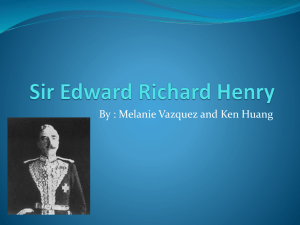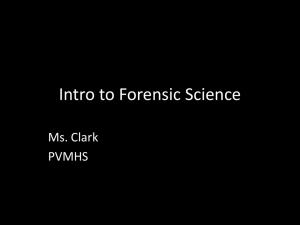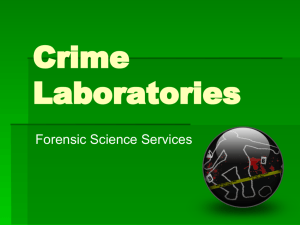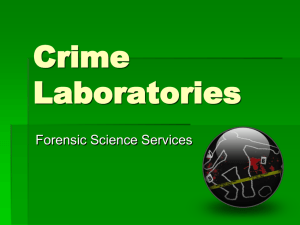CFS Bulletin imperfect Prints: the trouble with
advertisement
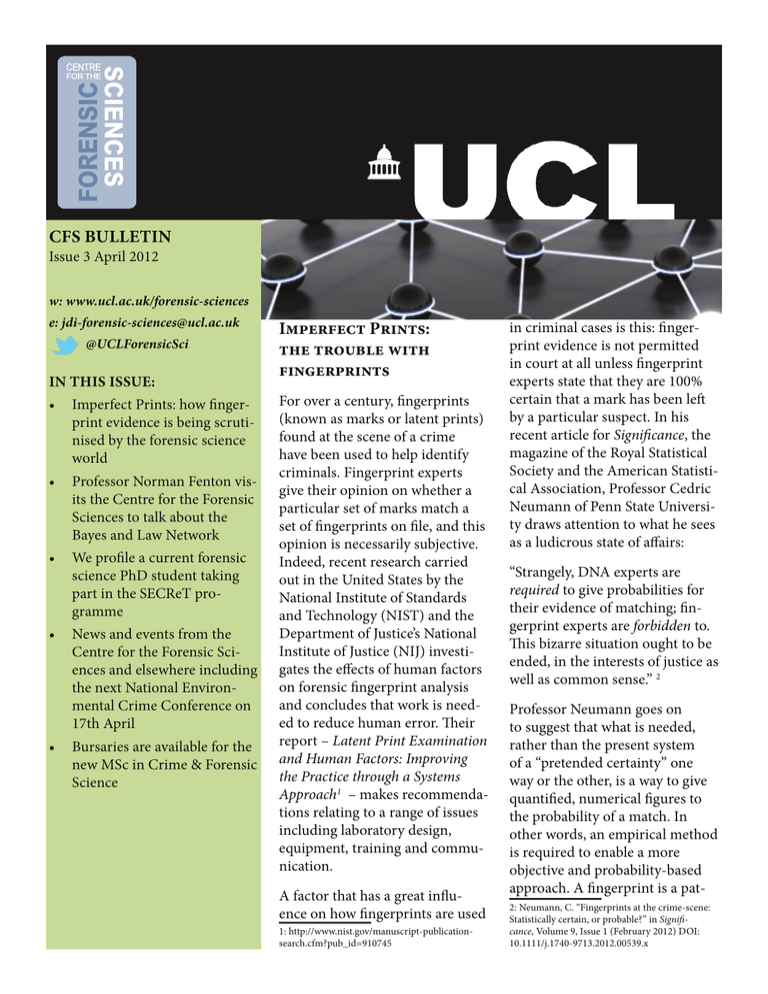
CFS Bulletin Issue 3 April 2012 w: www.ucl.ac.uk/forensic-sciences e: jdi-forensic-sciences@ucl.ac.uk @UCLForensicSci in this issue: • Imperfect Prints: how fingerprint evidence is being scrutinised by the forensic science world • Professor Norman Fenton visits the Centre for the Forensic Sciences to talk about the Bayes and Law Network • We profile a current forensic science PhD student taking part in the SECReT programme • News and events from the Centre for the Forensic Sciences and elsewhere including the next National Environmental Crime Conference on 17th April • Bursaries are available for the new MSc in Crime & Forensic Science Imperfect Prints: the trouble with fingerprints For over a century, fingerprints (known as marks or latent prints) found at the scene of a crime have been used to help identify criminals. Fingerprint experts give their opinion on whether a particular set of marks match a set of fingerprints on file, and this opinion is necessarily subjective. Indeed, recent research carried out in the United States by the National Institute of Standards and Technology (NIST) and the Department of Justice’s National Institute of Justice (NIJ) investigates the effects of human factors on forensic fingerprint analysis and concludes that work is needed to reduce human error. Their report – Latent Print Examination and Human Factors: Improving the Practice through a Systems Approach1 – makes recommendations relating to a range of issues including laboratory design, equipment, training and communication. A factor that has a great influence on how fingerprints are used 1: http://www.nist.gov/manuscript-publicationsearch.cfm?pub_id=910745 in criminal cases is this: fingerprint evidence is not permitted in court at all unless fingerprint experts state that they are 100% certain that a mark has been left by a particular suspect. In his recent article for Significance, the magazine of the Royal Statistical Society and the American Statistical Association, Professor Cedric Neumann of Penn State University draws attention to what he sees as a ludicrous state of affairs: “Strangely, DNA experts are required to give probabilities for their evidence of matching; fingerprint experts are forbidden to. This bizarre situation ought to be ended, in the interests of justice as well as common sense.” 2 Professor Neumann goes on to suggest that what is needed, rather than the present system of a “pretended certainty” one way or the other, is a way to give quantified, numerical figures to the probability of a match. In other words, an empirical method is required to enable a more objective and probability-based approach. A fingerprint is a pat2: Neumann, C. “Fingerprints at the crime-scene: Statistically certain, or probable?” in Significance, Volume 9, Issue 1 (February 2012) DOI: 10.1111/j.1740-9713.2012.00539.x tern: too complex as a whole for mathematics or even fingerprint experts to analyse. Certain parts of the print – arches, loops and whorls – are sufficient to be used for recognition and classification. In criminal cases finer detail is required and experts use points of detail called minutiae, of which there can be dozens in a whole fingerprint but very few in marks recovered from crime scenes. He proposes a new method, devised by his team at Penn State University, that derives numbers from these minutiae; arguing that this gives a more objective statistical rationale compared to the reasoning that currently leads experts from minutiae to identification: “…essentially a psychological one that cannot be rationalized and rendered explicit.” Their new method was tested for both positive and negative errors using marks or traces from the scenes of 364 crimes committed in Wales, UK compared to fingerprints obtained from the national fingerprint database in the US. The results were promising, and he hopes that in the future there will be “an evolution towards a framework that is similar to that which underpins DNA evidence.” Battles over this new method are expected, but he argues that models such as this one are “a powerful platform for change.” It remains to be seen how this article and the report published by the NIST and NIJ will influence the use of fingerprint evidence in the US and elsewhere. But many working in the field will see these recommendations and methods as positive developments in forensic science, hopefully leading to more robust evidence in court and consequently fewer miscarriages of justice in future. The Bayes and Law Network We were very pleased to have a visit from Professor Norman Fenton - Professor of Risk Information Management at Queen Mary, University of London - in March. He gave a seminar to academics and students from UCL and the University of Oxford on his recent venture: Bayes and the Law Network - Transforming Legal Reasoning through Effective Use of Probability and Bayes. This network is intended to explore the role of Bayesian reasoning in criminal justice, and has attracted senior academics in the fields of statistics, law, computer science and forensic science, as well as civil servants across Europe. The use of Bayesian networks in legal settings has been the subject of a recent ruling in the Court of Appeal: “...no attempt can realistically be made in the generality of cases to use a formula to calculate the probabilities...it is quite clear that outside the field of DNA (and possibly other areas where there is a firm statistical base) this court has made it clear that Bayes theorem and likelihood ratios should not be used.”1 Professor Fenton believes that as a result of this ruling, many lawyers are playing safe and avoiding the use of Bayesian tools such as likelihood ratios and probabilities, preferring to stick to verbal equivalents. He argued that Bayesian networks can be used with many different types of evidence, and that lawyers, judges 1: R v T, 2010 and juries should be able to understand Bayes theorem in its simplest form. In reality of course, things are rarely simple, but the use of Bayesian networks can help to clarify probabilities nonetheless. In answer to the argument that their complexity means formulae should not be used in court, due to the fact that jurors etc. cannot understand them, he used the analogy of a complicated sum, solved with the use of a calculator. No-one would suggest that the answer to the sum shouldn’t be relevant because they do not understand how the calculator itself works! In conclusion, Professor Fenton suggested that “the only rational way to evaluate probabalistic evidence is being avoided because of basic misunderstandings.” The challenge for his network is to develop methods to make building legal Bayesian network arguments easier for lawyers. It is a significant challenge, but one that academics, lawyers and judges alike would like to see overcome. To find out more about Professor Fenton’s work, visit his website and his blog on probability and the law: w: https://sites.google.com/site/bayeslegal/ w: http://probabilityandlaw.blogspot.com/ e: norman@eecs.qmul.ac.uk Cutting edge research A main aim of the CFS is to bring academics and practitioners together with students working within the field of forensic science, to facilitate cutting edge research. One such student is Nadia Abdul-Karim, enrolled on the SECReT doctoral training programme since 2010. Having graduated from Staffordshire University with a BSc in Forensic Science, Nadia felt that the opportunities offered by the 4-year SECReT programme would enable her to engage fully with industry, as well as other researchers. Her PhD - Investigating Patterns in the Spatial Distribution of Post-Blast Explosive Residues - aims to address the current lack of any scientifically valid method for locating explosive residues at crime scenes. Currently, crime scene investigators collecting evidence at the scene of an explosion will focus on collecting it from areas with obvious signs of damage. However, Nadia has found during the course of her research that these areas do not always yield explosive residue. Given the importance of collecting any residue as soon as possible, it is vital that investigators know where to look for it. For her MRes project, Nadia carried out several test explosions at Cranfield University’s Defence Academy of the United Kingdom, based in Shrivenham, Oxfordshire. Various sampling sites within range of the explosions were tested for residue. More residue was found closer to the centre of the explosion, and more residue was found when the height of the detonation was increased. An article on this research has recently been accepted for publication by the Journal of the Forensic Sciences. For her PhD, she is extending the research to examine confined detonations (e.g. explosives contained in small and large rucksacks and various metal encasings), the use of various explosives, and multiple sampling media. Results gained from chemical analysis, blast pressure measurements and high speed imaging technology will be compared in order to enhance understanding of the deposition of residues after a detonation. All students enrolled on the SECReT programme are required to show that their research has an impact on industry, and to this end they aim to collaborate with and gain sponsorship from different organisations within their chosen field. Nadia has successfully forged collaborations with Cranfield University, CAST (the Centre for Applied Science and Technology at the Home Office), the Forensics Explosives Laboratory at DSTL and the Metropolitan Police Service. The long term aim of this research is to help crime scene investigators retrieve and analyse explosive residue from scenes that by their very nature are chaotic and difficult to examine. By working closely with practitioners in the field and organisations with the equipment and expertise to help, Nadia is well-placed to achieve this goal. To see updates on Nadia’s research, visit the SECReT website. w: http://www.ucl.ac.uk/secret/homepage/ e: nadia.abdul-karim.10@ucl.ac.uk w: http://www.cranfield.ac.uk/ w: http://www.homeoffice.gov.uk/scienceresearch/cast/ w: https://www.dstl.gov.uk/ w: http://content.met.police.uk/Home What is SECReT? UCL SECReT is a £17m international centre for PhD training in security and crime science, the first centre of its kind in Europe. It offers a comprehensive integrated PhD programme for students wishing to pursue multidisciplinary security or crime-related research degrees. Students from a range of scientific backgrounds pursue research in crime or security domains across the engineering and social sciences. They can enter the programme through a number of funding routes (self-funded, industry sponsorship, scholarships). In 2012 there are 11 EPSRC scholarships available and the deadline is fast approaching, so interested applicants should visit the website: www.ucl.ac.uk/secret/homepage/ Stay in touch News and events National Environmental Crime Conference Tuesday 17th April 2012 Wellcome Collection Conference Centre, London From the illegal extraction and trade of natural resources to industrial pollution and illegal transport of hazardous waste, environmental crimes threaten national economies, human health and the global environment. Following on from the first two highly successful National Environmental Crime events, the NECC 2012 will bring together scientific communities, practitioners and the technology industry to reflect on the role of emerging technologies in the fight against environmental crime. Attendance at this conference is free and you can register here: http://www.eventbrite.com/event/3145364871 CFS Research Seminar Wednesday 9th May 2012 UCL We look forward to welcoming Mr Denis Edgar-Nevill (Canterbury Christchurch University) to talk about the increasingly important field of computer forensics. Advances in technology mean that criminal investigations must keep ahead of the game, and university-led research is key. Places at the seminar are limited, so if you would like to attend please email us for details. External events To keep up-to-date with news from the CFS, events we are running and external news in the forensic science field, why not visit our website and follow our newsfeed on Twitter? w: www.ucl.ac.uk/forensic-sciences @UCLForensicSci FSS Conference 28th April 2012 York e: jdi-forensic-sciences@ucl.ac.uk Are you open to Suggestion? The Role of Subjectivity and Influence in Evaluation Bursaries available for new MSc The Forensic Science Society will be holding a one-day conference in April to look at the role of Cognitive Bias in Forensic Science. w: www.forensic-science-society.org.uk/Events/2012/ 6th FORSTAT Workshop 5th-8thJune 2012 Edinburgh Forensic Evidence Evaluation: Problems and Applications The intention of the series of FORSTAT workshops is to train forensic scientists in the statistical evaluation of evidence. The level of the presentations is aimed at those who are forensic experts but may be beginners in statistics. Registration costs £225 and the deadline for registering is 1st May 2012. The new MSc in Crime & Forensic Science is proving very popular since applications opened on 1st January 2012. The CFS is providing two bursaries, which can be applied for at the same time as applying for the MSc programme. See our website for further details: www.ucl.ac.uk/forensic-sciences/teaching The deadline for bursary applications is 30th April, so don’t delay if you want to be considered. Awards will be made on the basis of academic merit. Applications for the programme itself are open until summer 2012 for the 20122013 academic session. cfs bulletin APRIL 2012 Editor: Kirstie Hampson w: http://ies.krakow.pl/conferences/forstat2012/ The next issue of the CFS Bulletin will come out in July 2012.



